Itinerary
Day 1
Depart the USA
Day 2
Arrive in Greece and travel the 30-minute drive into Athens. Get settle into our hotel and explore the surrounding area in the heart of Athens.
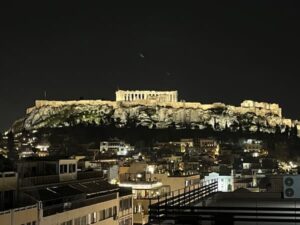
Get settle into our hotel and explore the surrounding area in the heart of Athens.
Day 3
Athens: the Ancient Agora (Marketplace), Areopagus Hill (Mars Hill), the Acropolis of Athens and the Parthenon. Stroll through the Plaka. (Overnight in Athens)
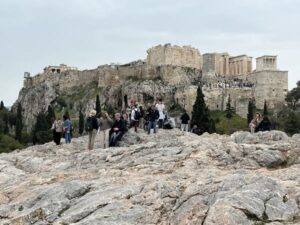
Athens: we will stroll through the Ancient Agora (Marketplace) visiting the Stoa of Attalos, a stoa lined with shops built in the 2nd century B.C. which has since been reconstructed for use as the Museum of the Ancient Agora. Here we visit many other ancient ruins/buildings of ancient Athens. This is where philosophers like Socrates gave advice to “know thyself,” and Zeno the Stoic lectured on how to control one’s emotions. This is also considered to be the seat of western democracy.
Our day in Athens will include walking up to the Areopagus (Mar’s Hill) a prominent rock outcropping located halfway up the hill to the Parthenon from the Agora. Acts 17:16-34 prominently features the Areopagus as the setting for the Apostle Paul’s Areopagus sermon to the philosophers during his visit to Athens, notably leading to the conversion of Dionysius the Areopagite. We will have a Bible study here from Acts 17:16-34.
Climbing a bit higher we will view Athens from the Acropolis and see the famous Parthenon, a former temple that was dedicated to the goddess Athena during the fifth century BC.
Coming down from the Acropolis a stroll through the charming Plaka and a delicious meal here will cap off our day. The Pláka is the old historical neighborhood of Athens, clustered around the northern and eastern slopes of the Acropolis, and incorporating labyrinthine streets and neoclassical architecture. Plaka is built on top of the residential areas of the ancient town of Athens.
Day 4
Drive to Mt. Olympus with stops at Marathon, the place of the 300 Spartans story, Mt Olympus (Overnight in Litichora—foot of Mt. Olympus)
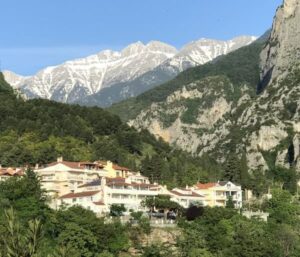
On this day, we will drive to base of the highest mountain in Greece, Mt. Olympus, making stops at Marathon, and Thermopylae (scene of the famous 300 Spartans).
Marathon is a small town which was the site of the Battle of Marathon (490 BCE), in which the heavily outnumbered Athenian army defeated the Persians. It’s believed that Pheidippides, a Greek herald at the battle, was sent running from Marathon to Athens to announce the victory, which is how the marathon running race was conceived in modern times. But there is a lot more to this story and you will learn it.
Thermopylae was the scene of famous battle (480 BCE) in central Greece at a mountain pass during the Persian Wars. The Greek forces, mostly Spartan, were led by Leonidas. After three days of holding their own against the Persian king Xerxes I and his vast southward-advancing army, the Greeks were betrayed, and the Persians were able to outflank them. Sending the main army in retreat, Leonidas and a small contingent remained behind to resist the advance and were defeated.
In the evening we will settle into our lodging quarters at the foot of Mt. Olympus in the small charming town of Litochoro.
Day 5
Travel to Thessalonica: visit the ruins of the ancient city, stroll along the harbour, take a boat ride in the harbor, and view the statute of Alexander the Great (overnight in Thessalonica)
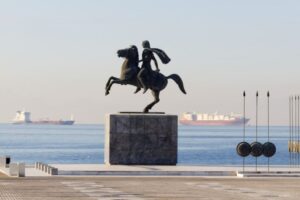
Travel to Thessalonica: Thessaloniki (pop. 814,000) is called the second capital by the Greeks, since it is not only the second largest city of Greece after Athens, but also the capital of Northern Greece and Macedonia. It is beautifully situated by the sea.
We will visit the ruins of the ancient city where Paul founded a church, stroll along the harbour, take a boat ride in the harbor/gulf (Aegean Sea), and view the statute of Alexander the Great
Day 6
Travel to Philippi, and visit the harbor in Kavala (Neapolis) where Paul sailed into from Troas in Turkey/Asia Minor (overnight at Philippi)
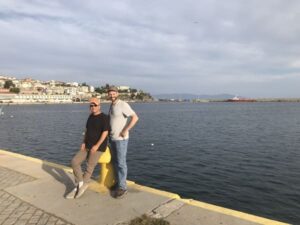
Leaving Thessalonika we will travel east to Philippi: After settling into our lodgings, we will travel eight miles to the coast and eat at the harbour in Kavala (biblical Neapolis), the one Paul sailed into from Troas in Turkey/Asia Minor after he received the “Macedonian vision” (Acts 16:6-12).
Day 7
Tour the archaeological site of ancient Philippi and have a Bible study from Philippians on the top of the acropolis of Philippi (overnight at Philippi)
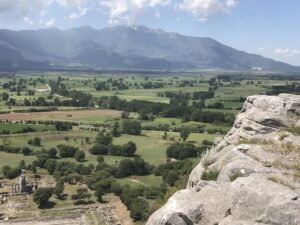
Tour the archaeological site of ancient Philippi where Paul and Silas were imprisoned for casting a spirit of divination out of a young slave girl and where they baptized their first European convert, Lydia, by the stream beside the town. We will have a Bible study from Philippians on the top of the acropolis of Philippi where we will enjoy a gorgeous view of the Macedonian mountains and plain below the acropolis where the great Roman civil war battle took place (42 BC). Here the forces of Octavius (Caesar Augustus) and Mark Anthony defeated the legions loyal to Brutus and Cassius, Roman senators, who were instigators in the murder of Julius Caesar two years earlier. This battle changed the ancient world forever as Rome was transformed into empire from a republic.
Day 8
Travel to Meteora with a stop in Berea
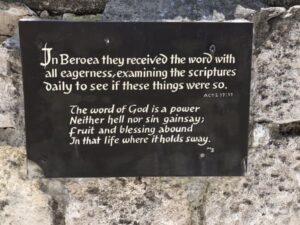
This will be a travel day to from Philippi to Meteora in the mountains of central Greece with a stop in Berea for lunch. It is believed that Paul was in the area where we will visit an ancient synagogue.
Berea is the place mentioned in Acts 17:10-12, “As soon as it was night, the believers sent Paul and Silas away to Berea. On arriving there, they went to the Jewish synagogue. Now the Berean Jews were of more noble character than those in Thessalonica, for they received the message with great eagerness and examined the Scriptures every day to see if what Paul said was true. As a result, many of them believed, as did also a number of prominent Greek women and many Greek men.
Late afternoon we will arrive to the stunningly beautiful area of Meteora and stay in the small town of Kastraki. Speaking for both Martha and me, this is definitely one of our favorite places in all of Greece.
Day 9
Meteora: visit the stunning monasteries built on the cliffs of central Greece
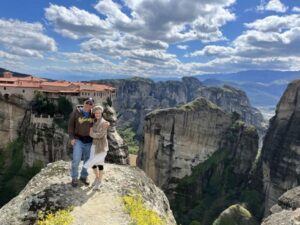
Meteora: Our visit here will take in at least two of the stunning monasteries built on the cliffs of central Greece. There are six Meteora monasteries perched on the huge cliffs people can visit today. Serene, mystical, extraordinary, breathtaking, immense, inspiring, impressive. These are only some of the words people very often use in an effort to describe the Meteora monasteries.
Day 10
Travel to Corinth with a stop and lunch at Actium, where the great battle between Octavian and Mark Anthony took place.
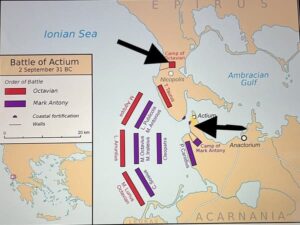
This day we will drive to Corinth with a stop and lunch at the strait of Actium where Octavian gained his celebrated victory over the forces Mark Antony and Cleopatra in 31 BC. This naval battle resulted in Octavias (Augustus Caesar) being the sole emperor of the Roman Empire. This same man would later give the degree that moved Joseph and Mary to Bethlehem where Jesus Christ was born fulfilling the prophecy of Micah the prophet. We will also visit the camp of Octavian, and where he later set up a memorial to himself for winning that historic battle
Day 11
Tour the ancient site of Corinth, hike on Acco-Corinth, walk over the bridge spanning the Corinth Canal.
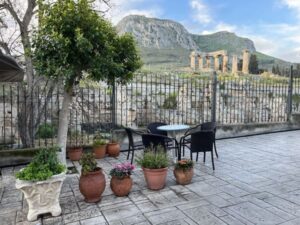
Tour the ancient site of Corinth where Paul founded a church and spent at least 18 months on his second missionary journey. The church in Corinth is where Paul directed two of his epistles. We will stand at the “bema” (seat of judgment), the place Paul stood before the proconsul of Achaia, Gallio, as recorded in Acts 18:12-17. Later we will drive up to and then hike on the mountain fortress of Acco-Corinth. Later in the day we will walk over the bridge spanning the Corinth Canal.
Day 12
Depart Greece
